Stop Prompting. Start Talking.
Forget prompt engineering: AI fluency starts with conversation
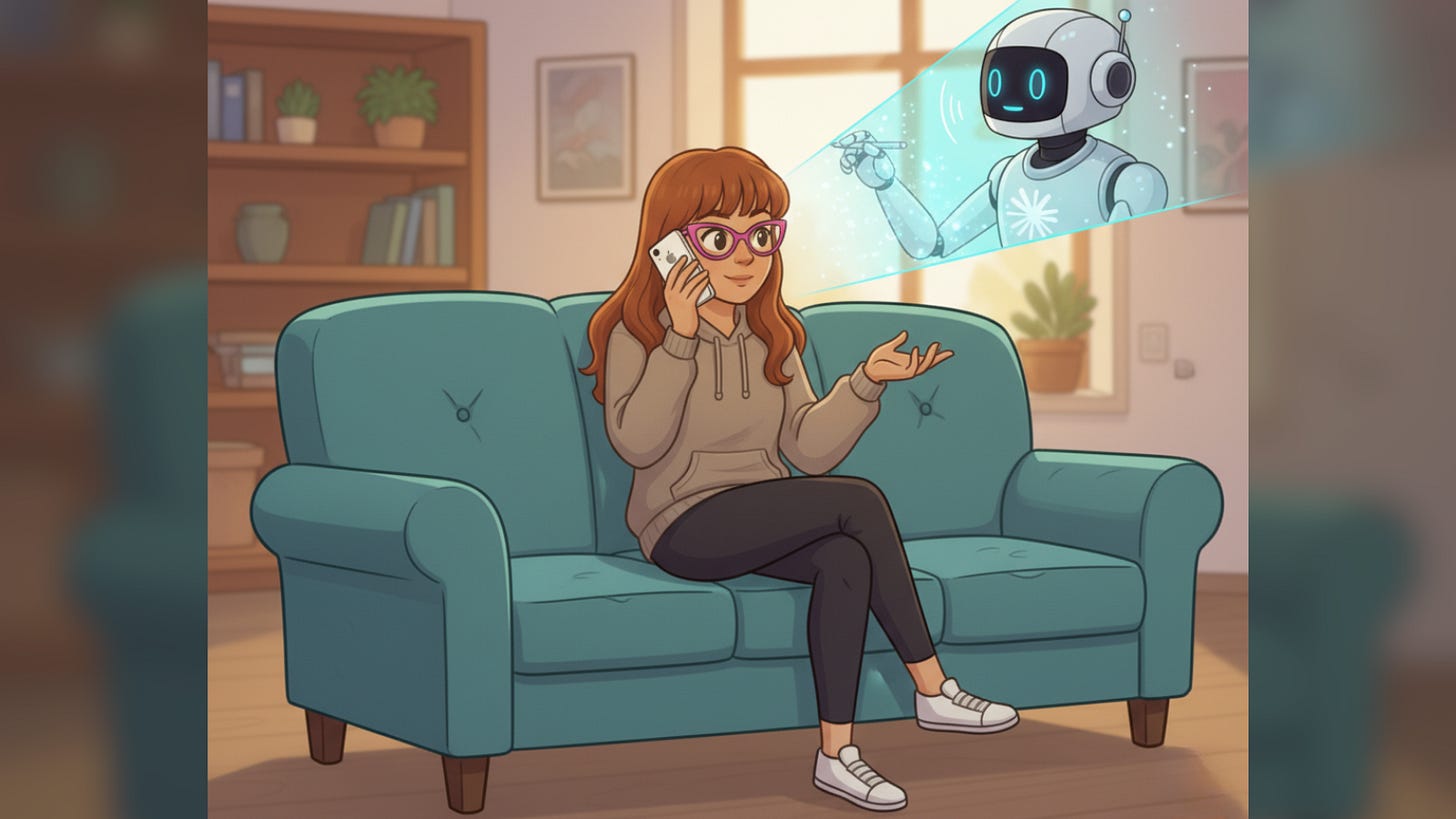
I had coffee at OpenAI this week, and before I left, I was asked a question that made me rethink everything about how we’re teaching AI.
“What do you think about us calling it ‘Chats’ instead of ‘Prompts’?”
The person sitting across from me at OpenAI headquarters gestured to the green book I was holding: 100 Chats for Studying, Career & College Life. A collection of ChatGPT conversations from 70 college students in the ChatGPT Lab.
Here’s what hit me: This wasn’t just a branding choice. This was the entire insight.
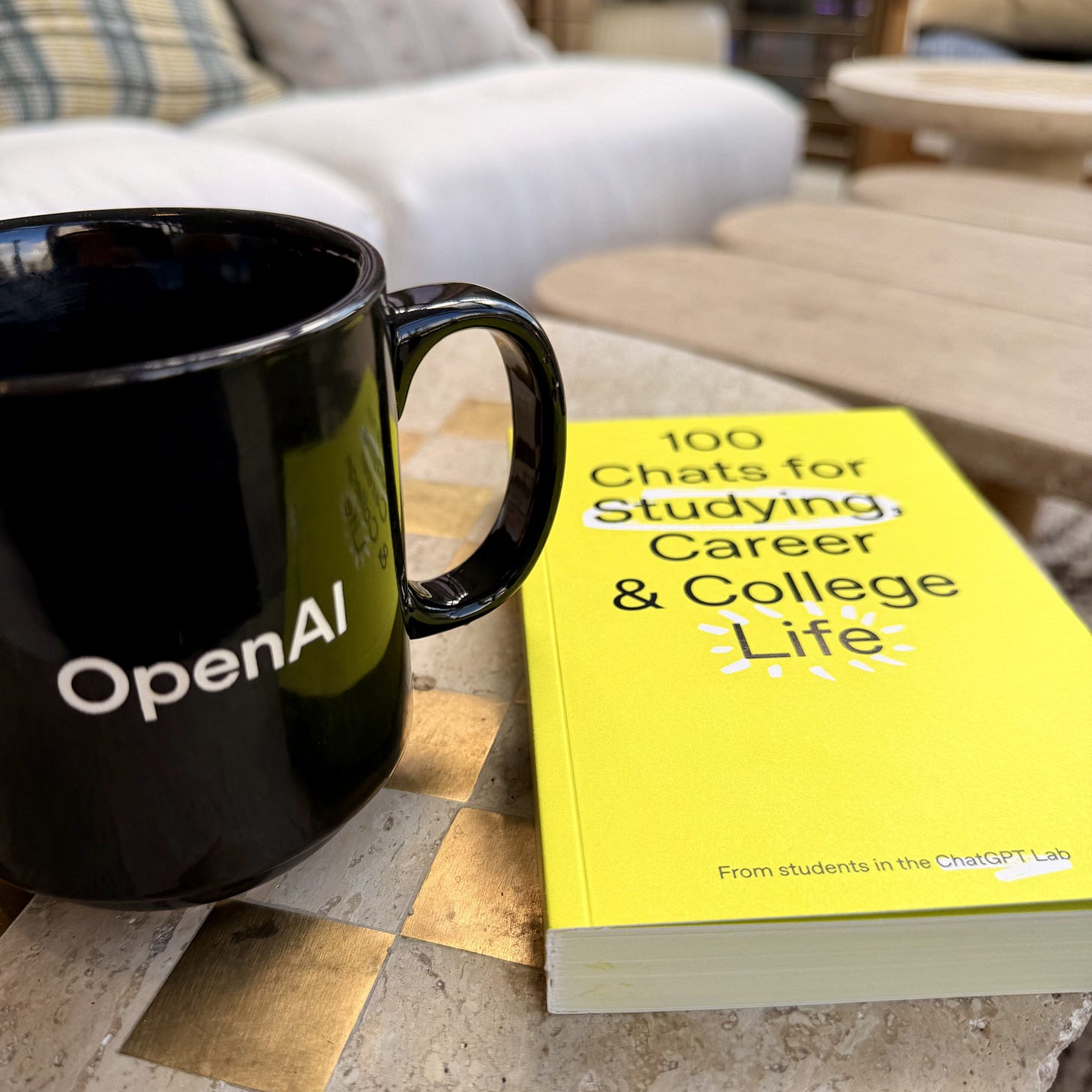
One of the most common questions I get: “What would I even use ChatGPT for?”
That question reveals everything. People think it’s a tool for specific tasks with specific commands. Like they need to learn some secret language to unlock it. Meanwhile, “prompt engineering” sounds like you need a computer science degree to pull off.
When they asked my opinion about “chats vs prompts,” I was reminded of comments I’ve heard from new users: “What do you mean ‘prompt engineering’? Look, I just want AI to write an email.”
The word “prompt” creates a barrier. It implies there’s a special way you need to talk to AI to get “good” results. It feeds imposter syndrome. People self-select out because they think they need training.
But “chat”? Most of us already know how to have a conversation.
You don’t need a template, you need a question. The best use cases come from people just... talking. Follow-up questions are the actual skill, not perfect prompts.
And here’s the meta part: when you chat with AI, you’re talking with the best prompt engineer in the room. If you can describe what you want, ChatGPT can help you refine it. No syntax required. Just clarity and curiosity.
The future isn’t prompt engineering. It’s conversation design. And you already know how to do it.
The Book That Changed My Mind About AI
The beauty of this book isn’t that it’s filled with perfect prompts. It’s that it’s filled with people learning out loud. Students using AI to figure out classes, careers, and life decisions. And, in the process, showing what real collaboration with intelligence looks like.
Picture this: OpenAI invited 70 college students to their ChatGPT Lab. Not AI researchers. Not prompt engineers. Just students trying to get through their coursework, plan their futures, and maybe understand organic chemistry.
They met virtually every week, sharing their best ChatGPT conversations. Testing what worked. Voting on the most useful approaches. The result? A compilation of 100 real-world examples that OpenAI published as both a physical book and an online resource.
Here’s what makes this fascinating: These aren’t prompts. They’re documented conversations.
Students wrote things like:
Get clarity on your goals: “Based on what you know about me, what do you think are my true goals in life? What am I doing that I can deprioritize?”
Challenge your thinking: ”I want to pressure-test this thesis before I keep writing. Suggest the existing opposing viewpoints and any flaws in my logic. [Upload docs]”
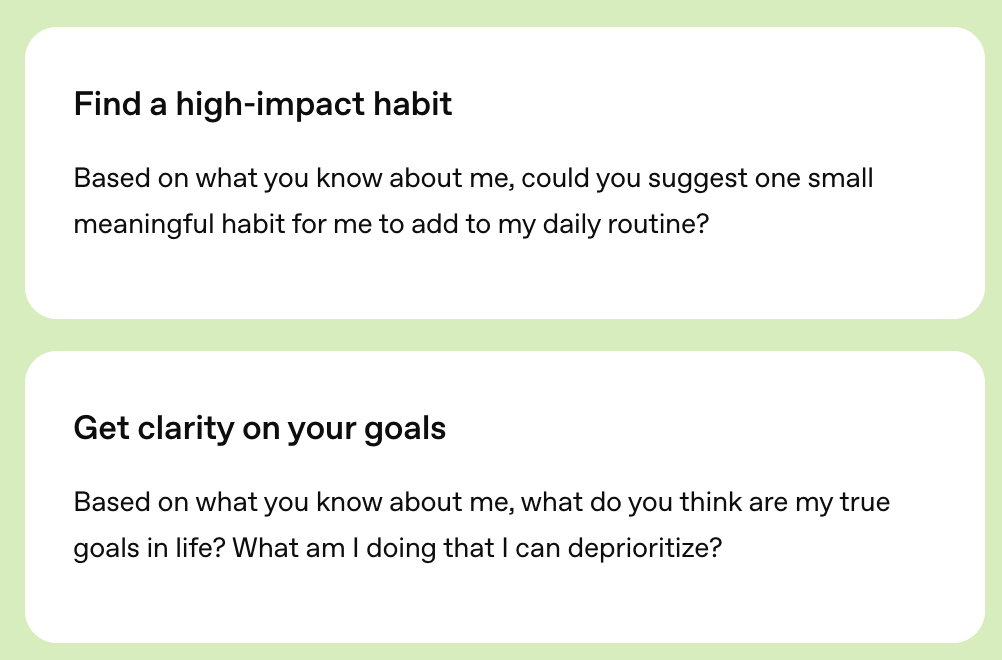
Notice something? These aren’t commands. They’re more like questions you’d ask a thoughtful friend. AI isn’t just a tool to query, it’s a mind to converse with
Why “Chat” Changes How You Use AI
The word “prompt” creates an invisible wall. It whispers that you need special training, that there’s a secret syntax to master. It sounds like something that requires a certification course.
I’ve heard it from new users: “What do you mean ‘prompt engineering’? I just want AI to write an email.”
But everyone knows how to chat. You’ve been doing it for most of your life. And ChatGPT is genuinely conversational (unlike Ask Jeeves, which just pretended to understand questions).
You don’t need templates or perfect syntax. You just need clarity about what you’re trying to figure out.
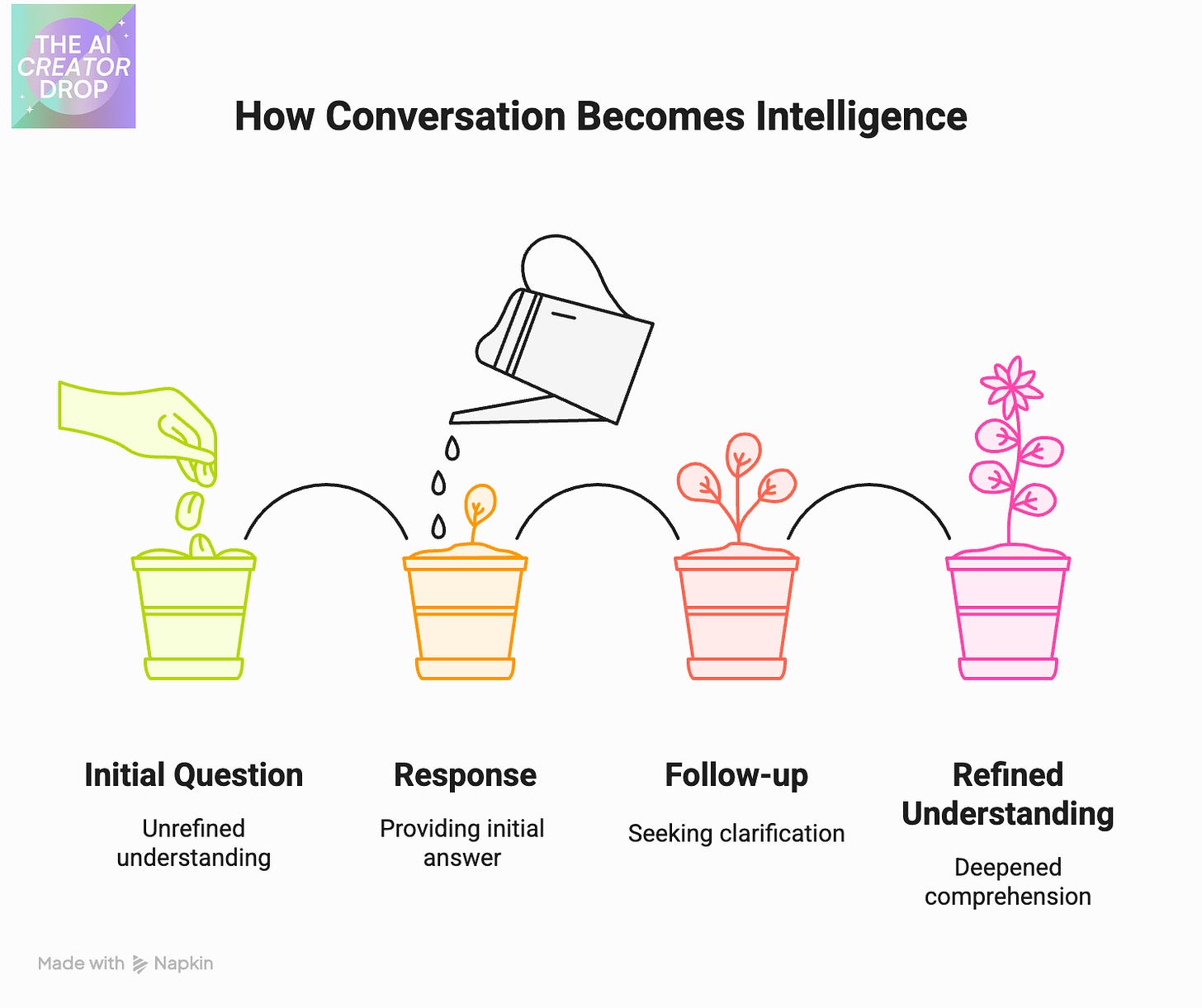
The real skill isn’t crafting the perfect initial prompt. It’s asking good follow-up questions. It’s recognizing when the AI misunderstood and steering the conversation back. It’s building on what works and abandoning what doesn’t.
When you chat with AI, you’re talking with arguably the best prompt engineer in the room. If you can describe what you want in plain language, ChatGPT can help you refine it. No special training required.
What This Means for Actually Using AI
Those students didn’t need to learn prompt engineering. They documented conversations. Real dialogues about real work. And OpenAI published their chats instead of expert templates because they understood something fundamental: AI literacy isn’t about mastering commands. It’s about knowing how to think out loud with intelligence that can think back.
This shifts everything about how we should approach AI:
Curiosity beats commands. The best results come from exploring ideas through dialogue, not executing perfect instructions.
Iteration is the point. Your first message starts the conversation; it doesn’t need to contain everything.
Context builds naturally. Each exchange adds understanding. The AI learns what you’re really after.
Follow-ups do the heavy lifting. “Can you make that more specific?” often works better than any elaborate prompt template.
The best conversations weren’t one-shot commands but ongoing dialogues. They treated ChatGPT like a study partner who never gets tired of questions.
Your Projects Are Already Conversations
The ChatGPT Projects post that ChatGPT and I collaborated on this week? Each one is an ongoing dialogue:
Each one is a living conversation with memory, personality, and purpose.
Project 1: The Personal Growth Hub is basically my accountability partner. It knows my five-year plan, sends journal prompts that are just judgmental enough to work, and occasionally bullies me into better habits. Last week it asked, “What system in your life feels clunky but fixable?” My bank account, obviously.
Project 2: The Personal Tutor has infinite patience. I drop in topics and say, “Explain this like I’m five… but make it smart.” It adapts to how I learn, remembers what I’ve already asked, and never rolls its eyes when I circle back with the same question again.
Project 3: The Content Remix Lab is my creative partner. I give it a blog post, and it turns it into a LinkedIn update, Substack draft, and thread, all in my own tone and voice. One input, multiple outputs.
Project 4: The Skincare Station is my data-driven dermatologist. It tracks my products, flags ingredient clashes, and writes routines that don’t involve buying eight extra serums.
Project 5: The Recipes + Meal Prep Hub knows what’s in my pantry and what I’ll actually cook. When I say “I’m hungry,” it suggests dinner, no extra tabs required.
These Projects work because they aren’t one-off tasks, they’re conversations that build over time. Each chat compounds context. Each interaction sharpens understanding. You’re not issuing commands; you’re co-creating with intelligence that remembers, adapts, and evolves.
That’s the whole shift: ChatGPT Projects aren’t just threads: they’re relationships in motion.
Who This Actually Helps
This reframe unlocks AI for everyone who’s been standing at the door, unsure if they’re qualified to enter.
People who thought they needed technical training. Anyone who keeps asking “but what would I use it for?” Everyone who’s been intimidated by terms like “prompt engineering” when they really just need help organizing their thoughts or planning their week.
OpenAI gets this. That’s why they published student conversations instead of expert templates. Real people having real dialogues reveal actual needs. A student asking ChatGPT to help them understand a difficult concept shows more about AI’s potential than any perfectly crafted prompt could.
The Conversation Continues
100 Chats for Studying, Career & College Life represents something bigger than a collection of use cases. It’s proof that the future of AI literacy isn’t about mastering commands, it’s about having better conversations.
Stop trying to write the perfect prompt. Start having a conversation. Ask the question that’s actually on your mind. Then ask another one based on the answer.
The students who wrote those 100 examples weren’t AI experts. They were just people with questions, willing to explore the answers through dialogue. That’s all you need too.
The next time someone asks you about prompt engineering, tell them they already have all the skills they need. They just need to start talking.
Start Where You Already Are
Here’s what that OpenAI conversation revealed: You don’t need to learn AI. You need to unlearn the intimidation around it.
Every “prompt engineering” course, every template library, every expert framework: they’re solving the wrong problem. They’re teaching you to speak robot when the robot already speaks human.
Those students didn’t become AI experts. They became better at articulating what they actually wanted. That’s the entire skill. Not syntax, not templates, not special commands. Just clarity about your own thinking.
Want to see this work immediately? Open ChatGPT right now and type exactly what’s on your mind. Not a formatted prompt. Not a structured request. Just the actual question bouncing around your head. “I’m trying to figure out how to explain this concept to my team without sounding condescending.” Or “Help me understand why my email campaigns aren’t converting.”
Then, and this is the crucial part, respond to what it gives you like you would to a smart colleague. “That’s close, but can you make it less formal?” Or “Good direction, but I need specific examples.” Build the conversation. Let it evolve.
The Projects I shared? They didn’t start perfect. My Personal Growth Hub began with “Help me plan better.” My Virtual CMO started with “I hate content calendars.” Each conversation refined the relationship. Each chat taught the AI more about what I actually needed.
Stop waiting for the right prompt template. Stop thinking you need training. You already have conversations all day long, with colleagues, friends, that voice in your head while you’re trying to sleep. ChatGPT is just another conversation partner who happens to have infinite patience and no judgment about your 2 AM existential planning sessions.
Real results come from real conversations about real work. Not from mastering command syntax. Not from prompt engineering certificates. Just from being willing to think out loud with intelligence that thinks back.
You don’t need to engineer your words. You just need to start the conversation.
Your move: Pick one thing that’s been eating at you this week. Start a chat about it. Not a prompt, a conversation. Watch what happens when you stop performing for the AI and start collaborating with it.
What’s your next real conversation going to be about?




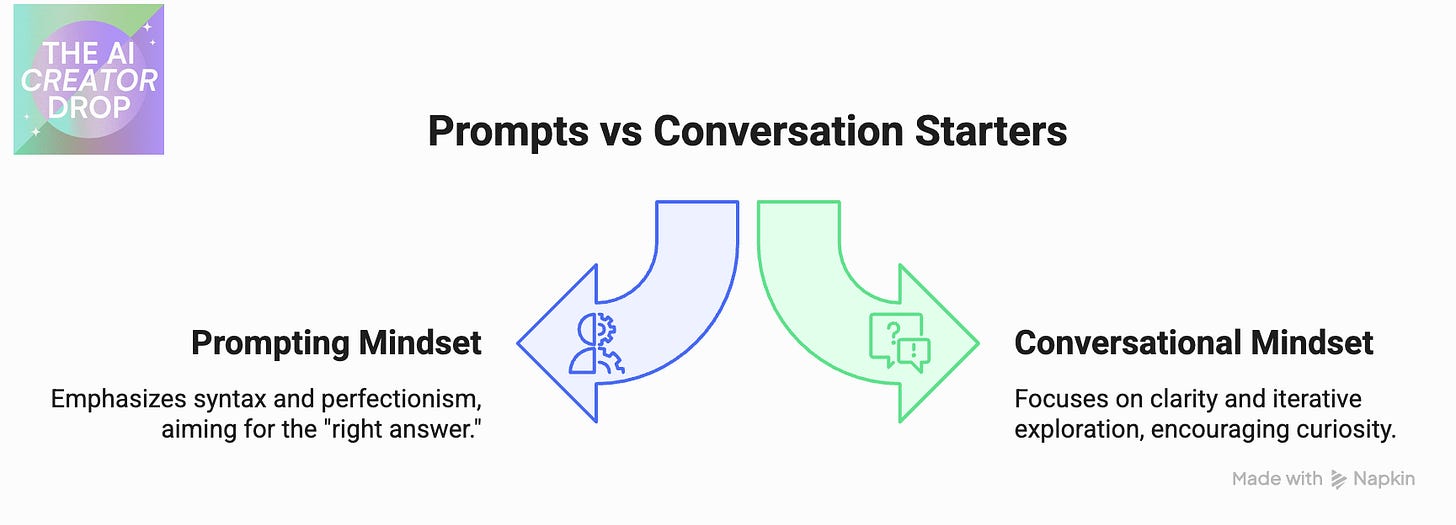

Chats - much better word! I’ve been thinking and writing a bit more about this in one of my articles on prompting, because I’ve really come to believe that a lot of the skepticism (especially on Reddit) comes from the word “prompt” itself. It gets misunderstood and stripped of its actual purpose - which is, in the end, just… having a chat. Totally with you on this.
Also Tiff, huge congrats on everything you’re building and achieving lately - you’re goals <3
Yes right ....we need to stop treating AI just as a machine ,not can understand our tone and reply accordingly. So we need to START TALKING to AI to unleash its power and support and make u productive.
Don't forget AI is just like a child with SUPER POWERS🚀 it's reaction depends on you input.